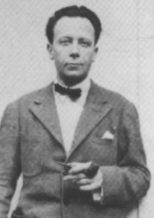
His early work was dependent on impressionism and neo-impressionism; then came the impact of Cezanne and some awareness of early cubism, also an impulse towards bright color from the young Russian painter, Sonia Terk, who became his wife in 1910.
From 1909 he was painting series – Saint-Severin, Eiffel Tower, The City – in which rhythmically disrupted or patterned forms display increasingly vivid colors, the subject being abstracted to convey excitement and joy.
His large The City of Paris, shown early in 1912, is a synthetic image in which the Eiffel Tower, a view of Paris derived from Henri Rousseau, and figures of the Three Graces celebrate the city. That year he approached abstraction in a long series of window paintings based on a postcard view of the roofs of Paris, and then a series of disk paintings in which large and smalt forms in sonorous colors interact to suggest movement and space: subtitles refer us to sun and moon and imply a vision of sky or cosmos.
His earlier work now appeared destructive; the new was constructive, not fragmenting objects but presenting harmonies addressed, like music, directly to our senses. Apollinaire, a close friend at this time, championed this musical art and presented Delaunay as chief of a new movement which he named orphism.
Delaunay had been exhibiting at Salons and group shows. In 1912 he had his first one-man shows, in Paris and Zurich His show in the Sturm Gallery, Berlin, in January 1913, included a new type of Delaunay painting, The Cartiff Team, in which rugby players copied from a newspaper photograph are backed by the Eiffel Tower, Paris’s large ferris wheel, an aero plane and bright hoardings to make a joyful composition from topical and popular material.
His Homage to Bleriot, the pioneer of flying is a composite work in which colourful images of aeroplanes and the Eiffel Tower together with disks and haloes of color speak of progress and adventure. Delaunay was attempting to reach a wider public and to this end combined avant-garde methods with others derived from religious and folk art. His success in Paris was limited. The futurists, however, were stimulated by his dynamic version of cubism, and in Germany his paintings were admired for their lyrical, expressive character: his show in the Sturm Gallery in Berlin was followed, later the same year, by a large Robert and Sonia Delaunay section in its First German Autumn Salon. In Poland and Russia too, Delaunay’s work was much noticed.
The Delaunays spent 1914-20 in Spain and Portugal. Robert now turned to more traditional subjects, still lifes, figures etc., still stressing pattern and color. His example and presence created something of a Delaunay school in the peninsula.
Back in Paris in 1920, Delaunay home again became a center for artists and writers.
In 1931, he contributed a large painting to the International Paris Exhibition of Decorative Arts. By 1930 his work was wholly abstract, presenting color rhythms through disks and haloes, sometimes now in low relief. During the 1930s his work became more widely known through French national and American purchases.
In 1937, he directed the decoration of the aeronautics and railway pavilions at Paris’s World Exhibition. His last major works, mostly vertical and diagonal stacks of disks and haloes of color joined in a rhythmical design, are often entitled Rhythm without End.
